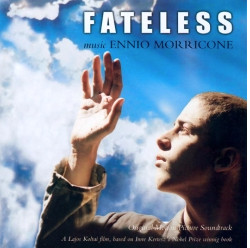Original Review by Jonathan Broxton
Director Lajos Koltai’s film Fateless (Sorstalanság) has finally reached North America cinemas almost a year late, having been an art house and film festival hit across Europe following its initial release in February 2005. A historical drama based on Nobel laureate Imre Kertesz’s semi-autobiographical novel about Hungarian Jews during the Holocaust, it stars Marcell Nagy as Gyuri Köves, a young Jewish boy from Budapest who is pulled from a bus on his way to a war labour job and sent to the terrible Buchenwald concentration camp, where he must endure all manner of horrific experiences and harsh living conditions just to survive.
With a budget of over $12m, Fateless is one of the most expensive and ambitious Hungarian films ever made. Director Koltai is most famous in Hollywood as a cinematographer, having worked with directors such as István Szabó and Giuseppe Tornatore in a 30-year career. Fateless is his directorial debut. Unsurprisingly, given the prestigious nature of the project, Koltai turned to one of Europe’s most revered and respected composers to write the score: Ennio Morricone, writing his seventh score of 2005. Considering his advancing years (he turned 78 last November), the fact that Morricone continues to be prolific is nothing short of astounding. It’s also astounding that, despite having written over 500 scores in a 45-year career, he is not resting on his laurels or simply coasting towards retirement. Fateless was nominated for a European Film Award in 2005, as has been the recipient of a great deal of well-deserved praise from the film music world for his work.
It’s become accepted within the cinematic world that movies which deal with events on the monumental scale of the Holocaust are underscored with beauty: the juxtaposition of shocking visual imagery of mass human suffering with music of immense grace and lyricism somehow makes the tragedy more tragic, the horror more horrific, and the emotional impact more deeply felt. Over the years, composers from John Williams to Georges Delerue have understood this connection between beauty and misery, and Ennio Morricone for once does not buck the trend. His musical depiction of life in a concentration camp focuses on the hope that prevails in these places, on the way in which humanity finds a way to shield itself from the depravity of the world around them, and how, even in the darkest moments, brightness somehow prevails.
Anyone familiar with Morricone’s canon will know what to expect when I say that Fateless is a classic example of his melodic style: there are echoes of Once Upon a Time in America, The Mission, and his rejected score for What Dreams May Come when listening to Fateless’s main theme, which bookends the album. One of the most remarkable cues is “Return to Life”, which begins with a pipe organ, switches to an oboe solo, segues into a full choir, and ends with a superb Lisa Gerrard vocal, all backed by a sweeping string section. One of it’s recapitulations, in “About Solitude”, is subtly beautiful.
Yes, I said Lisa Gerrard. One of the most interesting things about Fateless is Morricone’s decision to have Gerrard take on the role which Edda dell’Orso has so wonderfully fulfilled in previous scores – the provision of wordless vocals. Gerrard contributes her lush, immediately-recognisable voice to a number of tracks, including the soaring “A Song” and the almost ecclesiastical “A Voice from the Inside”. Those familiar with her work via her collaborations with Hans Zimmer, or her solo scores, may be surprised at the range, depth of emotion, and classical style her voice brings to this score. Her performances are definite highlights.
The rest of the score continues in a similar vein: respectful, solemn, but wholly beautiful reflections in the nature of war, life, death, and redemption. Other cues are notable for some of their instrumental choices: the breathy pan flute which first appeared briefly at the end of “Return to Life” reappears during “The Beginning of the Tragedy”, and “To Return and Remember”, which also features an unexpectedly jaunty performance of that most Hungarian of instruments, the cimbalom. “The Field” is a more dramatic, urgent piece with an increased level of brass; “Home Again” is a soft, pastoral, wistful duet for piano and oboe, again backed by strings; “Psychological Destruction” is a clever menacing combination of snare drums and tremolo strings, with a brass performance of the main theme just peeking through the gloom.
It really is no wonder that Ennio Morricone is so revered amongst his contemporaries, and continues to be cited as an inspiration for composers across the world. His career has nothing been short of groundbreaking, and his gift for melody, orchestration and emotion is at times quite astonishing. Fateless reminds us of why he is held in such high esteem, but equally reminds us of what Hollywood is missing out on by continually failing to give him quality projects to score, or by constraining his uniqueness into the confines of demographics. I daresay Morricone is happier working in Europe, and shows no sign of slowing down, despite his advancing years. Fateless is one of the scores of the year in anyone’s estimation, and an early contender for the top honours of 2006.
Rating: ****½
Track Listing:
- Fateless (3:08)
- Return to Life (5:57)
- The Field (3:30)
- Home Again (1:50)
- The Beginning of the Tragedy (4:01)
- A Song (1:55)
- At The Table (2:44)
- Psychological Destruction (2:00)
- About Solitude (1:34)
- To Return and to Remember (1:54)
- A Voice from the Inside (3:35)
- A Mirror (0:47)
- About Solitude II (2:41)
- Voiceless (1:54)
- Fateless II (4:35)
Running Time: 45 minutes 05 seconds
EMI Music 7243-860331-2-3 (2005)
Music composed and conducted by Ennio Morricone. Performed by The Hungarian Radio Orchestra and Chorus. Orchestrations by Ennio Morricone. Featured musical soloists Ulrich Herkenhoff, Agnes Szakaly and Ludovico Fulci. Special vocal performances by Lisa Gerrard. Recorded and mixed by Fabio Venturi. Album produced by Ennio Morricone.












